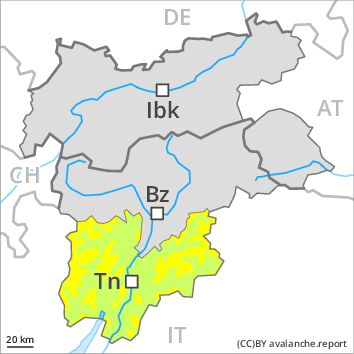Regions
Latemar, Southern Adamello, Primiero - Pale di S. Martino, Adamello - Presanella, Prealps, Northern Brenta - Peller, Cembra Valley, Bondone and Stivo, Vallarsa, Western Nonsberg Alps, Folgaria - Laverone, Southern Brenta, Fassa Valley, Sole, Pejo and Rabbi, Southern Lagorai, Ledro Valley, Northern Lagorai, Maddalene, Paganella, Marzola - Valsugana, Pine' - Mocheni Valley

Danger level
Avalanche Problem
Wind-drifted snow above the treeline, N-NE-E-SE-S-SW-W-NW

Moderate, level 2. Wind slabs require caution, especially at elevated altitudes adjacent to ridgelines.
The sometimes strong wind will transport only a little snow. The fresh wind slabs are mostly easy to recognise but to be assessed with care and prudence. Even single persons can release avalanches in isolated cases, including medium-sized ones. The avalanche prone locations are to be found also at transitions from a shallow to a deep snowpack above approximately 2200 m. Off-piste activities call for meticulous route selection, in particular on steep slopes above approximately 2000 m and adjacent to ridgelines and in pass areas. In steep terrain there is a danger of falling on the icy crust. Backcountry touring calls for caution and restraint, in particular above approximately 2000 m on shady slopes.
Snowpack
The fresh wind slabs have formed especially adjacent to ridgelines and in gullies and bowls. These are bonding only slowly with the old snowpack in particular on steep shady slopes above the tree line. Faceted weak layers exist deep in the old snowpack in high Alpine regions, in particular on northeast, north and northwest facing slopes in areas where the snow cover is rather shallow. The surface of the snowpack has frozen to form a strong crust only at high altitudes and will soften during the day. The snowpack will be moist at low and intermediate altitudes.
Tendency
A latent danger of natural moist avalanches exists, in particular on sunny slopes and on very steep grassy slopes.